Developing Skills for Business Leadership
The below is a module submission for the CIPD Level 7 certification, kindly shared by one of our clients to help you on your own HR journey. This submission is about developing skills for business leadership.
a) Presentation Slides and Supporting Notes
Slide 1: Introducing Myself
Notes:
This slide is designed to provide an overview of the information outlined in my CV and cover letter by way of an introduction. If I were to summarise my biggest strengths in relation to this role, it would be my ability to adapt and flex to the needs of the business I am working with or within.
I class myself a lifelong learner, but this is not just in relation to academic studies, I am someone who is always reading and looking to expand my knowledge and understanding of the world. I am passionate about sharing this learning with others, which I do in several different ways which I will expand on as I walk you through my evidence in response to each learning objective.

Slide 2: Overview of learning objective 1
Notes:
When I took the decision to leave my corporate career and establish myself in business at the end of 2017, I wanted to share the lessons I had learned. I started writing a blog called ‘Ladder Climbing in High Heels’ which then evolved into content for a book. The concept was that I was sharing all of the things I wish I had known at the start of my career journey, which I called my ‘ladder lessons’. This was aimed at a female audience, largely because I had encountered challenges in being a feminine woman working in largely male dominated organisations. Like many other women, I faced a number of challenges in relation to my gender and was keen to share advice that could help other women navigate these.

Theodorou (2022) shares some of these challenges and the fact that she believes that even in 2022 there is still a long way for women to go to achieve true equality in the workplace and beyond. Like me, she hopes that by bringing awareness to these issues and educating others on them, we can continue to pave the way for future generations and create safe spaces for them to excel in.
I had to be driven and self-motivated to write the book, particularly as it coincided with me trying to establish myself in business as an independent consultant. I had to learn how to manage myself as a business owner – this was a very different proposition; no-one was going to pay me at the end of the month unless I went out and sold myself and tried to obtain clients. I always say that working alone was the biggest self-development journey I have ever embarked upon, and no-one can prepare you for it. I found those early months in business extremely lonely and I sought support from a mentor who had been in my shoes. As the organisation Start Up Loans (part of the British Business Bank PLC) state (2022) ‘a mentor can provide valuable insight and experience that can really make a difference in those early stages’.
Through working with a mentor, I began to understand that I missed the team environment and wasn’t well suited to working in isolation. Whilst I was working with clients, I wasn’t quite at the stage of being in the ‘trusted advisor’ space. Instead, I was given pieces of work to complete and fulfil in my own time, away from their office. I spent over eight months in that environment before I sought an opportunity to join Cheshire West & Chester local authority regeneration project, Northgate, as an external advisor on their media engagement and strategic approach to communications. It was through this opportunity that I was introduced to other business owners in and around the locality and headhunted to join a local law firm (Hillyer McKeown) to support them with the expansion of their business consultancy firm. To cut a long story short, this was the predecessor to the business that I co-founded, DICE. I look back upon this period of my career and reflect that it was one of the most difficult.
During the early part of the Covid-19 pandemic I was furloughed and found myself turning to self-learning for solace. I decided to create a leadership programme which was designed to take all the learnings I have been fortunate to be exposed to over 20 years and aimed at the SME market, who are renowned for having a ‘grow your own’ mindset when it comes to leadership. Leadership development in SME’s is something which the Department for Business, Energy & Industrial Strategy (BEIS) identified as needing investment in their 2019 policy paper, the SME action plan. They attempted to do this through their £20m Small Business Leadership Programme and Peer Networks in 2020/21.
I have subsequently had the programme, which consists of 16 modules, CPD accredited (see appendices) and have delivered the content to over 60 people from several businesses in the last two years.
Finally, I took the decision at the end of 2020 to launch a podcast which was in a similar vein to my book and involved sharing ‘ladder lessons’ both of my own and of other people that I interviewed. I interviewed a range of business owners, public sector workers, senior leaders from across the corporate sector and even a student who had won a young enterprise award. Similarly to my book, neither of these things were designed to do anything other than fulfil a passion for learning from others and sharing that learning to help others.
Related reading: For even more useful content on leadership, check out our ultimate guide on Leadership Skills.
Slide 3: Overview of Learning Objective 2
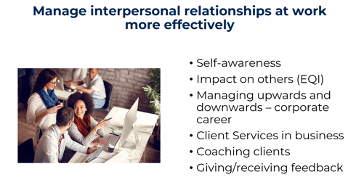
Notes:
I pride myself on my ability to build and sustain relationships at work. I believe that my success in doing so began with my own journey into self-awareness and learning more about my personal motivators and what drives me. I am a fan of psychometric profiling and have found this useful at different stages of my career, both in understanding more about myself but also about others.
People Management (2022) reports 81% of people using psychometric tools make more reliable decisions, while 57% believe psychometrics can help predict future performance.
Through having greater self-awareness I learned more about my impact on others and my ability to influence others. I am a fan of Emotional Intelligence theory and have had training to address some of the blockers that held me back in my early career, such as feelings of not being enough. The Emotional Intelligence Training Company Inc. (2022) say that emotional intelligence skills are critical for building relationships and teams, resolving conflict, solving problems, leading effectively, and building resilience.
In my corporate career I was always balancing the needs of those above me in the hierarchy and my sub-ordinates – I call this managing upwards and downwards. In middle-tier positions such as this one, this is often the most challenging part of a role. Often you are putting out fires before they escalate, but at the same time are required to ensure the right level of information and detail is provided to inform strategic decision making. This oscillation between operational and strategic needs is one that undoubtedly will be required in this role.
Managing client relationships is another dynamic which it has taken me several years to finesse! There is a balancing act between being the trusted advisor and pointing out where a business or an individual needs to change, and ensuring you are seen as ‘on their side’ and not just calling out problems for the sake of it. It is with this in mind that my mantra is to seek solutions to any problems. You have to remember that the client is paying for your advice and therefore you have to sometimes be the grit in the oyster – you can’t always be the friend, you have to be the coach.
Venkatesh (2019) predicted that the market size of the coaching industry will $20 BN globally in 2022. He also identified that the biggest challenge facing the industry is that it is unregulated. Personally, I believe there is a significant responsibility as a Coach with any advice you provide. One of our Values at DICE is that we every business as if it were our own and this is my North Star when it comes to coaching clients.
Slide 4: Overview of Learning Objective 3
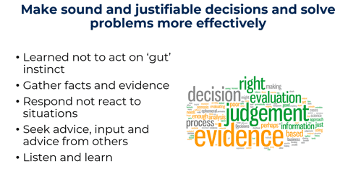
Notes:
As mentioned, through psychometric testing, I learned a great deal about myself – including my preference for decision making. Understanding that my preference to make decisions through ‘gut instinct’ could be holding me back was helpful in moving towards more of an evidence-based approach.
As the CIPD (2022) recognise, an evidence-based approach to decision-making is based on a combination of using critical thinking and the best available evidence. It makes decision makers less reliant on anecdotes, received wisdom and personal experience – sources that are not trustworthy on their own.
In addition, through working on my personal mindset and approach to life generally, I have learned to respond rather than react to situations. When I worked for the Environment Agency, I had to deal with a number of crisis issues such as major flooding across Britain. This required a calm and level-headed approach – particularly when dealing with the general public who were frightened and highly emotive about losing their properties and possessions. I have since realised that I took a ‘conscious leadership’ approach in these situations which helped me to retain a calm approach, even when the situation was extremely challenging. The Conscious Leadership Institute (2022) describes the guiding principles of Conscious Leadership as: know and manage self, practise presence and openness, realising potential and purpose, foster an inclusive orientation.
Finally, I believe the most important thing I have learned in making sound decisions and solving problems is to seek advice and input from others – listening and learning to gather information. Obviously this has to be timely and relevant, it cannot be a hindrance to decision making progress, however when time allows, this approach can really help with helping people to feel engaged in the final outcome.
Slide 5: Overview of Learning Objective 4

Notes:
My leadership style is ‘servant leadership’ which is sometimes described as an ‘upside down’ pyramid approach. LeadX share that research has shown that servant-led companies are more likely to outperform competitors, retain employees, and develop future leaders than companies that operate out of more traditional “command-and-control” leadership styles.
Marrying up the desires and motivations of the employee with the needs of the business is something that I always strive to do. Influencing people can sound like it is Machiavellian, however I believe that done right and with the best of intentions, it can influence people to do great things that they might not have had the self-belief, confidence or desire to do previously.
For instance, when leading transformation or change programmes, which is a key part of the HR role, it is important to inspire a will to change. It’s about creating the compelling story around what will be better as a result of making the changes. As humans, we inherently do not like change, and knowing that in any change we will go through the stages of the change curve can really help us pre-empt people’s concerns and prepare them the best we can through strong communications and a willingness to listen.
Of course it isn’t just people that we need to influence in the workplace. In my varied roles in the public sector there was always a need to influence the resource allocation for my department which was challenging against a backdrop of budgetary constraints. In the same way as HR has become sharper at being able to quantify impact on the organisation, the Communications function had to do the same.
As Strategic HR (2018) outline, The HR impact on the bottom-line is about metrics. HR needs to be able to measure activities and show cost savings and benefits to the organization. Some examples include how much is the new programme saving you on turnover or absenteeism? What is a lack of training costing the company?
One of my most challenging roles in my corporate career was when I was promoted into a leadership position that required me to lead a team of highly skilled engineers and technical specialists. I had to influence them that whilst I wasn’t a chartered engineer, I was an expert in my own field and had their best interests at heart. I attribute my success in doing this to getting to know them as individuals, what their motivations were, and adopting a servant leadership approach.
Slide 6: Overview of Learning Objective 5

Notes:
My communications expertise means that I find it easy to interpret complex information and make it ‘Plain English’ for people to understand. During my time working on the strategic team taking Eddie Stobart from private ownership to publicly listed on the AIM market, I learned a great deal about how to do this with financial information. I worked closely with the Financial Analysts to pull together information for potential investors. Personally, I am not a finance expert, but I have come to realise that numbers tell a story about what is happening in a business. I am comfortable working alongside the financial experts to support them in articulating their information in the best possible way for the audience.
In starting up my own business I have learned even more about managing financial resources, such as registering for VAT and understanding some of the nuances around tax. We have taken The Lean Start-Up (2022) approach to our business, which is the build-measure-learn feedback loop. The first step is figuring out the problem that needs to be solved and then developing a minimum viable product (MVP) to begin the process of learning as quickly as possible. Once the MVP is established, the key is to implement, measure and learn so that you can continually improve and develop the product/service offering.
As aforementioned, working in the public sector for many years meant I became adept at managing tight financial resources. One of the main challenges in the public sector is that reward and renumeration has tight controls around it and therefore we couldn’t use those to motivate people. Whereas in the private sector salary and bonuses can and are used to do so.
Slide 7: Overview of Learning Objective 6

Notes:
I have demonstrable proficiency in my IT skills, which I have taught myself over serval years. For instance, developing my blog website katecousens.com, self-publishing my book on Amazon and creating my Podcast Ladder Down. In creating these I took a step-by-step approach to getting them off the ground. I am a big fan of breaking down big tasks into bite-sized chunks or baby steps. In adopting this approach I am able to work through and learn as I go.
In terms of relevance for this role, again I am self-taught in the suite of Microsoft packages and able to use the main packages of Word, Excel and Powerpoint to an enhanced proficiency. As Lonsdale (2020) explains, self-discipline is one of the most important elements of self-directed learning. I would say this is one of my strengths alongside self-motivation….if there is something that needs doing, I am not afraid to learn how to do it!
That said, I wouldn’t say I am an IT expert, however I am an early adopter of new technology. It helps having teenage children as they are always one step ahead of the latest trend or gadget!
Slide 8: Overview of Learning Objective 7
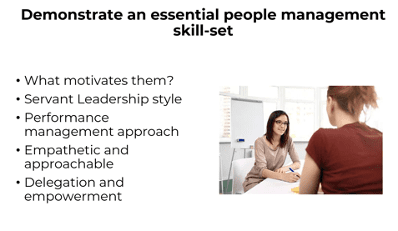
Notes:
As mentioned earlier, when it comes to people management, I adopt a Conscious Leadership approach and Servant Leadership style. In doing so this is about putting the employee at the centre and adapting my style to suit them.
I am a believer in using performance management tools to manage people most effectively. There is no ‘one size fits all’ approach to people management and therefore using regular 1-1 meetings to check-in with where an employee is at with their objectives, as well as understand how they are feeling more generally, is extremely useful.
Natural HR (2021) state that continuous, effective performance management helps foster an open dialogue between employees, management and the company as a whole. This increases trust and ensures everyone feels better supported and more engaged. Without this, employees are more likely to feel detached from their work and its role within the organisation, which is very likely to result in a higher rate of staff turnover.
As I have said before, I pride myself on being empathetic and approachable. This means that people generally trust me and can share their concerns or feelings with me. As a people manager this is really important as it helps me to be able to step in with the right interventions for them.
Through delegating key tasks to people, you can empower them to deliver above and beyond what they may see as their capability at that time.
Slide 9: Overview of Learning Objective 8
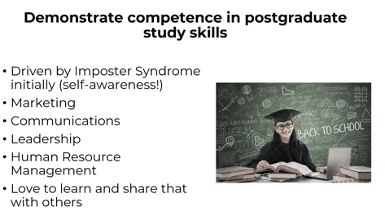
Notes:
Please see section b for notes relating to this learning outcome, which I perceive to be a strength.
b) Strength – Learning Objective 8
Since graduating in the year 2000 with a Media & Cultural Studies with Human Resource Management degree, I have fulfilled a number of post-graduate studies which have supported learning throughout the varied roles of my career.
I initially went into a Public Relations space within the field of Communications and found that there was a close relationship to Marketing which led me to embark on a post-graduate Diploma with the Chartered Institute of Marketing, which I studied part-time and completed in 2009. I found this a useful basis in understanding more theory related to business sales and how to generate interest in both products and services. I would say that these studies supported my ability to be able to lead compelling campaigns with the Environment Agency, such as the rod-licence campaign which was the organisation’s only product offering to the general public. I came up with the concept of ‘James Pond – licence to fish’ which successfully ran as a local campaign in 2008/9. Social media was in its infancy, but we were able to focus on young male fisherman who might be tempted to go fishing without a licence and then run the risk of a high fine. The coverage is still available to view online and I have included a link to one of the articles in the appendices.
Following career moves into senior leadership roles, I embraced myself in a number of different programmes which supported my personal development. I was the youngest person in the Environment Agency to be invited onto their Executive Management talent programme in 2012, which was a 12-month programme of intense personal learning on areas such as Emotional Intelligence and Coaching.
As well as being certified by the Institute of Leadership & Management, this programme involved spending time at University of Exeter Business School (24-27 September 2012) in a contemporary debate ‘Leadership Matters’. I was able to apply the learning in my day job but at the same time it also massively boosted my confidence and following completion I applied for a secondment outside of the Environment Agency to work on a regeneration project called The Atlantic Gateway, which was the precursor to the work which merged into the Northern Powerhouse.
It was working on this programme where I was introduced to Alex Aiken, the Director of Government Communications who invited me onto their talent programme (Inspire) where I was fortunate enough to complete a Postgraduate certificate in Strategic Communications via the University of Huddersfield in 2015. I have included a link in the appendices with more information about the current programme. One of the highlights of that programme was spending a week working at Google where we were exposed to a very different approach to public sector communications!
I have reflected that a lot of my drive around post-graduate study has come from my feelings linked to Impostor Syndrome. Despite being a highly driven individual, I have always needed the external validation of a qualification to really feel like I am able to do my job (whatever it is) to the best of my ability. This is described as ‘The Expert’ by Sheqworx (2021), in the five types of Impostor Syndrome – someone who is constantly signing up for new training courses and qualifications to improve their skills and top up their knowledge.

It was these feelings that have led me to my most recent studying for the CIPD Level 7 course. During the Covid-19 pandemic I had a real crisis of confidence around my HR knowledge. I studied HR in my degree but that was over 20 years ago and being in the HR consulting space I felt I owed it to my clients to get myself professionally qualified in the field to the highest level. I have learned a number of things during the programme and it gives me greater confidence in the advice and support I give knowing that I am armed with the CIPD industry knowledge.
c) Reflections on Presentation
I have found this one of the most enjoyable assignments on the programme so far. It is rare that I stop and look back on my career and my studies and see how far I have come.
Looking specifically at the presentation, I can see that my preference to invest in content rather than creativity is shown! I could have approached the slides with more of a design flair, however this isn’t one of my areas of strength and I prefer to invest my time in ensuring the words I produce are of the highest quality.
Looking over my notes, I can see that my tendency to ‘sell myself’ in an interview scenario has come across strong! I do struggle with sharing my weaknesses in this context as I am always driven towards winning and getting the job.
With this in mind, there is one stand-out slide where I have skirted around a gap in my skillset. That is around learning objective 5 – the financial information. I have been exposed to a lot of this in my career, however I am not a huge fan of detailed financial reports and when it comes to complex business issues such as EBITDA, I am always the first to refer to an expert rather than try and fudge or guess my way through. I know my strengths and my weaknesses and financial information, and data is definitely on the lower end of the scale. I was honest in sharing I am not a finance expert and neither do I think I would need to be to fulfil the role successfully.
d) Continuous Professional Development
I hope I have demonstrated that my approach to continuous professional development is just that – continuous. I am always reading, listening to podcasts, learning and in turn I pride myself on sharing that learning with others.
Looking ahead to the remainder of the Level 7 programme, I am going to embark on the ‘Investigating Business Issues in HR’ next. Following the completion of that I will be undertaking the examination assessments for Human Resource Management in Context and Leading, Managing and Developing People. It is my aspiration to complete my Level 7 studies during the Summer of 2022.
After that I will continue self-studying, taking a break from academia for a while – although I would like to do something else in the future, perhaps a Masters degree. Looking further ahead to the future, I could see myself writing more books and I’d like to write one on the subject of people leadership as there are many things I see in client’s businesses repeatedly that I think I could help to solve through a mainstream book.
Appendices
DICE CPD accreditation certificate:
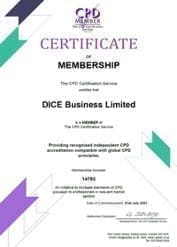
James Pond Licence to Fish media coverage : James Pond – Licensed To Fish – Anglers’ Net (anglersnet.co.uk)
Inspire Government Communication Service Talent Programme: https://gcs.civilservice.gov.uk/career/progress-your-career/inspire-programme/#:~:text=For%20senior%20GCS%20professionals%20%28grade%206%2F7%29%20Designed%20to,with%20an%20option%20to%20continue%20to%20an%20MSc.
References:
CIPD (2022). Evidence-based practice for effective decision-making. (14/4/22). Available at: https://www.cipd.co.uk/knowledge/strategy/analytics/evidence-based-practice-factsheet#:~:text=An%20evidence-based%20approach%20to%20decision-making%20is%20based%20on,sources%20that%20are%20not%20trustworthy%20on%20their%20own. d (accessed 21/6/22).
Department for Business, Energy & Industrial Strategy (2019). BEIS small and medium sized enterprises (SME) action plan. 6/3/19. Available at: https://www.gov.uk/government/publications/beis-small-and-medium-enterprises-sme-action-plan/beis-small-and-medium-sized-enterprises-sme-action-plan (accessed 20/6/22).
Emotional Intelligence Training Company Inc. (2022). EQ-i 2.0 is the world’s leading measure of emotional intelligence. (2022). Available at: https://www.eitrainingcompany.com/eq-i/ (accessed 22/6/22).
LeadX (2022). Servant Leadership: Definition, Examples, Characteristics. 2022. Available at: https://leadx.org/articles/servant-leadership-definition-examples-characteristics/ (accessed 22/6/22).
Lonsdale, M (2020). What is Self-Directed Learning – and Is It Important? (3/7/20). Available at: https://mentoreducation.co.uk/learning-tips/what-is-self-directed-learning-and-is-it-important/ (accessed 22/6/22).
People Management (2022). Why You Should Use Psychometric Profiling (And How to Do It). 8/3/22. Available at: https://www.linkedin.com/pulse/why-you-should-use-psychometric-profiling-how-do-tony-nutley (accessed 21/6/22).
Natural HR (2021). Employee Performance Management: What is It & What Are Its Benefits? (6/11/21). Available at: https://www.naturalhr.com/2019/12/12/6-benefits-of-performance-management/ (accessed 21/6/22).
Sheqworkx (2021). Is Imposter Syndrome holding you back (and what you can do about it)?. Is Imposter Syndrome holding you back (and what you can do about it)? (7/10/21).
Start-Up Loans (2022). The importance of mentoring to the success of new businesses. (2022). Available at: ttps://www.startuploans.co.uk/business-advice/the-importance-of-mentoring-to-the-success-of-new- businesses/#:~:text=Make%20time%20for%20your%20business%20mentoring%20sessions.%20Regular,month%20in%20the%20first%20year%20of%20your%20business. (accessed 20/6/22).
Strategic HR (2018). How Can HR Impact the Bottom Line? 2022. Available at: https://strategichrinc.com/how-can-hr-impact-the-bottom-line/ (accessed 21/6/22).
The Conscious Leadership Institute (2022). Guiding Principles. 2022.
The Lean Start Up (2022). The Lean Start Up Methodology. 2022. Available at: https://theleanstartup.com/principles (accessed 21/6/22)
Theodorou, M (2022). 15 Important Issues Women Still Face at Work. 8/3/22. Available at: https://www.careeraddict.com/women-workplace (accessed 20/6/22).
Venkatesh, U (2019). Coaching Industry – Statistics. 11/9/19. Available at: https://www.linkedin.com/pulse/coaching-industry-statistics-umesh-venkatesh (accessed 21/6/22).




